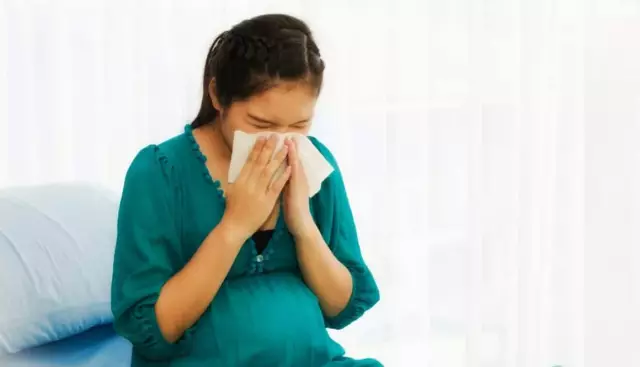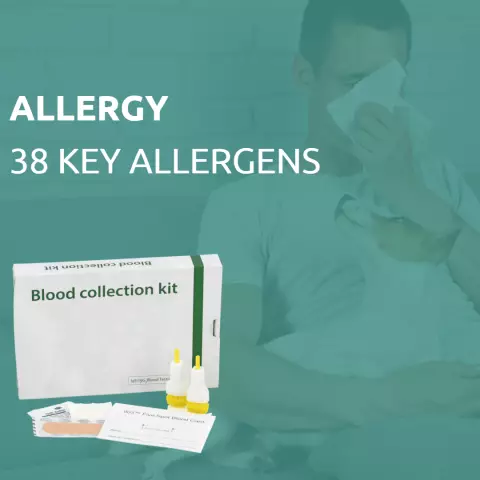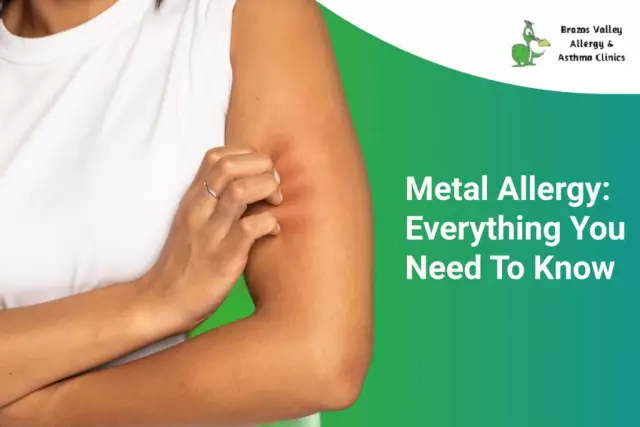- Author Rachel Wainwright [email protected].
- Public 2023-12-15 07:39.
- Last modified 2025-11-02 20:14.
Cold allergy
The content of the article:
- Causes and risk factors
- Forms of the disease
- Cold allergy symptoms
- Diagnostics
- Cold allergy treatment
- Diet for allergies to cold
- Potential consequences and complications
- Forecast
- Prevention
Cold allergy is a pseudo-allergic reaction resulting from exposure to low temperatures on the human body. Despite the fact that the disease is widespread, modern medicine has recognized its existence relatively recently.

Skin manifestations of cold allergy
Allergy to cold is diagnosed several times more often in women than in men. She usually manifests at the age of 20-30.
Cold allergy symptoms can come from contact with cold water, being outside in cold weather, strong cold winds, or eating cold food or drinks.
Causes and risk factors
Cold allergy is a pseudo-allergic reaction that differs from true allergy in the absence of certain immunological mechanisms. With pseudoallergy, the development of the inflammatory process is associated with disturbances in the exchange of histamine. Experts put forward three theories to explain the development of cold allergy:
- Vascular spasm of the microvasculature. Under the influence of low temperatures, a person experiences a spasm of the smallest blood vessels - capillaries, as a result of which the blood supply and tissue nutrition deteriorates, which becomes the beginning of the inflammatory process.
- Formation of special proteins. In some people, under the influence of low temperature in the body, special biochemical processes are triggered, during which proteins are synthesized that can act as an allergen. It is these proteins that trigger the release of allergy mediators (histamine, serotonin), provoking the development of allergic inflammation. These proteins are not persistent and are quickly destroyed when a person is warmed.
- Dry skin. With dry skin, its surface is not sufficiently protected. In the cold, because of this, cells quickly lose moisture, the skin becomes even drier and begins to peel off. This theory is supported by the fact that allergy to cold is most often diagnosed in people with sensitive and dry skin, as well as in elderly patients.
Factors that increase the risk of developing a cold allergy are:
- diseases of the gastrointestinal tract (peptic ulcer and duodenal ulcer, chronic pancreatitis, hepatitis, cholecystitis, pronounced intestinal dysbiosis);
- foci of chronic infection (vaginitis, salpingitis, pyelonephritis, cystitis, periodontitis, otitis media, tonsillitis, sinusitis);
- systemic lupus erythematosus and other autoimmune pathologies;
- hemoblastosis;
- diseases of the thyroid gland;
- helminthic invasions;
- diabetes.

Thyroid disease increases the likelihood of developing a cold allergy
Cold allergy often develops in patients suffering from any other manifestations of allergies (pollen or household allergies, atopic dermatitis, etc.).
Forms of the disease
The following forms of cold allergy are distinguished:
- cold dermatitis;
- cold urticaria;
- cold conjunctivitis;
- cold rhinitis;
- cold form of bronchial asthma;
- mixed;
- familial cold urticaria.
Cold allergy symptoms
The most common manifestation of cold allergy is cold urticaria. After contact with cold water or air on the parts of the body in contact (usually the face, neck, ears, hands), the skin begins to ache and itch badly. Then it gradually turns red and blisters form on it. In appearance, the changes in the lesion are very similar to the symptoms of a nettle burn. With a large area of rashes, the patient's blood pressure can sharply decrease, up to the development of a collapse.

Cold urticaria symptoms
Familial cold urticaria (one of the forms of cryopyrin-associated periodic syndrome) is a separate form of allergy to cold. The disease is associated with a defect in the NLRP3 gene and is inherited in an autosomal dominant manner. With familial cold urticaria, cold allergy symptoms do not appear immediately, but several hours after exposure to low temperatures on the body: a maculopapular rash appears on the skin.
Allergy to cold, flowing like cold dermatitis, is characterized by the formation of burgundy or dark red spots with a slightly flaky surface in open areas of the skin. Their size reaches 2-5 cm in diameter. The appearance of rashes is accompanied by a pronounced burning sensation and severe itching. After a while, cracks form on the surface of the spots, then they are covered with crusts.
Cold dermatitis most often affects the skin of the hands, neck, ears and face, that is, those areas of the body that are not covered by clothing. In very rare cases, rashes can also appear on closed areas of the body, for example, on the inner thighs or knees.
The main symptom of cold rhinitis is a transient rhinitis accompanied by mucous discharge. Its characteristic feature is that it appears when the patient comes into contact with low temperatures, and in a warm room, after warming up, it completely passes on its own.

With cold rhinitis, a runny nose occurs after being in the cold
Cold conjunctivitis is manifested by increased lacrimation, pain in the eyes, and minor blepharospasm. In the warmth, the phenomena of cold conjunctivitis pass on their own.
The effect of cold air on the mucous membrane of the bronchi in some people leads to the development of bronchial hyperreactivity - a bronchoconstrictor reaction of the respiratory tract. Clinically, this is manifested by an attack of bronchial cold asthma:
- labored breathing;
- dyspnea;
- cyanosis of the nasolabial triangle;
- on auscultation - multiple wheezing in the lungs.
Diagnostics
If a cold allergy is suspected, the patient should be consulted by an allergist. To confirm the diagnosis, a cold test is performed: a small piece of ice is placed on the patient's skin and left for 3-5 minutes. If the test is positive, typical cold urticaria develops in the area of contact of ice with skin. If necessary, pH-metry of the skin and dermatoscopy of the rash elements are additionally performed.

A cold test helps to determine allergies to cold: a piece of ice is applied to the skin for a while
A blood test allows you to determine in the serum the presence of proteins specific to cold allergy (cryoglobulins, cryofibrinogen, cold antibodies).
In some patients, an exacerbation of allergy to cold may be accompanied by the appearance of blood proteins in the urine (hemoglobinuria).
To identify the underlying disease that caused the formation of allergy to cold, the patient is sent for consultation to narrow specialists (gastroenterologist, gynecologist, urologist, dentist, endocrinologist, etc.).
If there are indications, an additional laboratory and instrumental examination is carried out, which may include:
- bacteriological culture of discharge from the nasopharynx;
- bacteriological analysis of feces;
- general analysis of feces and urine;
- Ultrasound of the abdominal and pelvic organs;
- pharyngoscopy;
- rhinoscopy;
- fibroesophagogastroduodenoscopy (FEGDS).
Cutaneous forms of cold allergy should be differentiated from dermatitis caused by other causes (contact, drug, atopic dermatitis), as well as psoriasis.
Cold allergy treatment
Treatment of allergy to cold, first of all, consists in preventing the patient from further contact with the cold (warm clothes in winter, bathing in warm water, refusal of cold food and drinks). In winter, especially on windy days, any greasy cream should be generously applied to exposed skin before leaving the house.

It is important to limit the contact of the patient's skin with cold
In the complex treatment of allergy to cold, antihistamines, multivitamin preparations, as well as preparations that improve microcirculatory blood circulation and trophic processes are used. In addition, therapy for the identified concomitant diseases is carried out.
Tempering procedures are recommended for patients with mild symptoms of cold allergy. Hardening begins with pouring warm water (water temperature 37-37.5 ° C). Every five days, the water temperature is lowered by one degree, gradually increasing to 10 ° C. If, with the next decrease in water temperature, clinical manifestations of allergy to cold occur, the temperature is again raised to tolerable, then after a few days it is again reduced. Tempering treatment is allowed only in patients with mild disease. With a violent cold allergy, dousing with cold water can lead to the development of anaphylactic shock - a potentially life-threatening complication.

Tempering treatments are recommended for people with cold allergies
A relatively new method of treating cold allergy is autolymphocythotherapy, which consists in administering lymphocytes previously obtained from his own blood to a patient. The course is usually prescribed 8 procedures performed every other day. Autolymphocythotherapy has established itself as an effective and at the same time safe method of treating cold allergy.
Diet for allergies to cold
In case of an exacerbation of allergy to cold, it is recommended to adhere to a hypoallergenic diet. The following should be excluded from the diet:
- spicy, salty, fatty and fried foods;
- strong broths;
- spices;
- smoked meats;
- sausages;
- seafood;
- eggs;
- ice cream;
- processed and spicy cheeses;
- industrially prepared sauces (ketchup, mayonnaise);
- pickles and marinades;
- some vegetables (bell peppers, tomatoes, spinach);
- nuts;
- mushrooms;
- citrus;
- confectionery.
It is recommended to include in the diet:
- dairy products;
- cereal dishes (except semolina);
- lean meat;
- mild varieties of cheese;
- green apples;
- vegetable oil;
- vegetable dishes, preferably green ones (zucchini, cabbage, squash, green beans, green peas, dill, parsley, etc.).
Potential consequences and complications
With a severe clinical course and the absence of timely treatment, cold allergy can lead to the development of serious complications:
- laryngeal edema - usually develops after eating cold foods or drinks. The patient suddenly develops inspiratory dyspnea (difficulty breathing), there is a sensation of a foreign body in the throat. The voice becomes hoarse and muffled.
- anaphylactic shock - its first symptom is usually a sharp pain in the area of skin rashes, then vascular collapse and bronchospasm rapidly develop. The symptoms of anaphylactic shock develop rapidly, and if the patient is not given immediate medical attention, he may die.

Like other allergic reactions, cold allergies can cause anaphylactic shock
Long-term allergy to cold has a negative impact on the mental state of patients. In the cold season, many of them have increased fatigue, nervousness, and in severe cases depressive states develop.
Forecast
In most cases, allergy to cold does not pose a threat to the patient's life. However, the disease is long lasting and requires regular therapy. With severe allergic reactions to cold exposure, it may be necessary to change your place of residence.
Prevention
As part of the prevention of the development of allergy to cold, diseases of the gastrointestinal tract, endocrine system, helminthic invasions should be diagnosed and treated in a timely manner, as well as all foci of chronic infection in the body should be sanitized.
In cold weather, dress warmly and protect exposed areas with a greasy cream, especially for people with dry skin.
If you plan to stay in the cold for a long time, you should take a thermos with a hot drink with you. A few sips of hot liquid allows the body to quickly warm up and thus prevents the development of cold allergy symptoms. But it is categorically impossible to use alcoholic beverages in the cold for the purpose of warming! Alcohol promotes expansion of the skin capillaries and thereby enhances the transfer of heat from the body. As a result, hypothermia develops, and the prerequisites are created for starting the pathological mechanism of cold allergy.
YouTube video related to the article:

Elena Minkina Doctor anesthesiologist-resuscitator About the author
Education: graduated from the Tashkent State Medical Institute, specializing in general medicine in 1991. Repeatedly passed refresher courses.
Work experience: anesthesiologist-resuscitator of the city maternity complex, resuscitator of the hemodialysis department.
The information is generalized and provided for informational purposes only. At the first sign of illness, see your doctor. Self-medication is hazardous to health!






